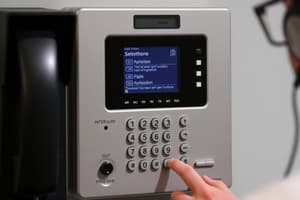Podcast
Questions and Answers
What is the purpose of the 'DOIO' call in the operating system?
What is the purpose of the 'DOIO' call in the operating system?
- To identify the device corresponding to the specified stream
- To signal when the I/O operation is complete
- To check the parameters of the I/O request for consistency (correct)
- To add an IORB to a queue of similar blocks
What does the 'mode' parameter in the 'DOIO' call indicate?
What does the 'mode' parameter in the 'DOIO' call indicate?
- The operation required, such as data transfer or rewind (correct)
- The amount of data to be transferred
- The number of the stream on which I/O is to take place
- The address of a semaphore request serviced
Where is the device corresponding to the specified stream determined from?
Where is the device corresponding to the specified stream determined from?
- The parameters of the I/O request
- The stream descriptor list of the calling process (correct)
- Information held in the device descriptor
- The amount of data to be transferred
What happens if an error is detected during the checking of I/O request parameters?
What happens if an error is detected during the checking of I/O request parameters?
What does the 'semaphore' parameter in the 'DOIO' call represent?
What does the 'semaphore' parameter in the 'DOIO' call represent?
Once the 1/0 procedure checks have been completed, what does it do next?
Once the 1/0 procedure checks have been completed, what does it do next?
Study Notes
I/O Request Format
- A typical I/O request to the operating system has the format: DOIO(stream, mode, amount, destination, semaphore)
- DOIO is the system I/O procedure name
I/O Request Parameters
- Stream: the number of the stream on which I/O is to take place
- Mode: indicates the operation required (e.g., data transfer or rewind) and character code to be used
- Amount: the amount of data to be transferred (if applicable)
- Destination (or source): the location for the data transfer
- Semaphore: the address of a semaphore request to be signaled when the I/O operation is complete
Device Identification
- The device corresponding to the specified stream is determined from the stream descriptor list of the calling process
- The list is consulted at the time the stream was opened
Error Checking
- The parameters of the I/O request are checked for consistency against the device descriptor information
- If an error is detected, an exit can be made to the caller
I/O Request Processing
- The I/O procedure assembles the request parameters into an I/O request block (IORB)
- The IORB is added to a queue of similar blocks representing other requests for the same device
- Requests in the queue may come from the same process or other processes (in the case of a shared device like a disk)
Studying That Suits You
Use AI to generate personalized quizzes and flashcards to suit your learning preferences.
Description
Learn about the general form of a system I/O procedure call in operating systems, including the parameters like stream number, operation mode, data amount, destination, and semaphore. Understand how different aspects like data transfer and character codes are handled in this call format.



